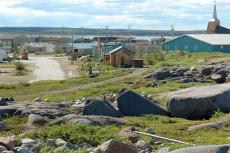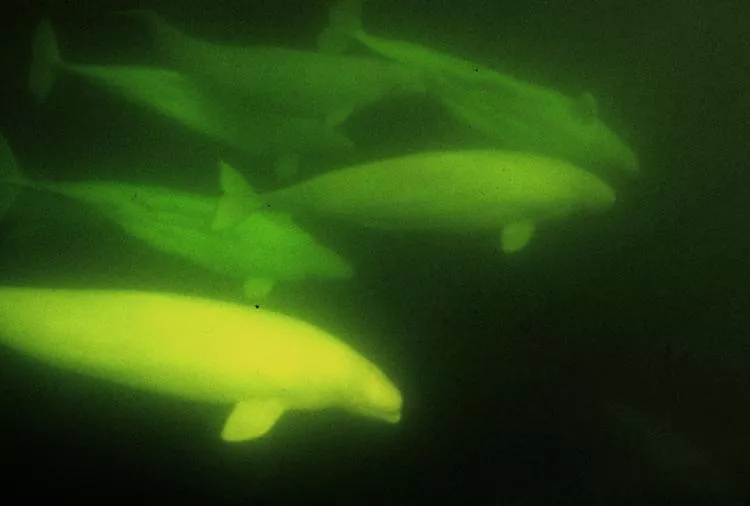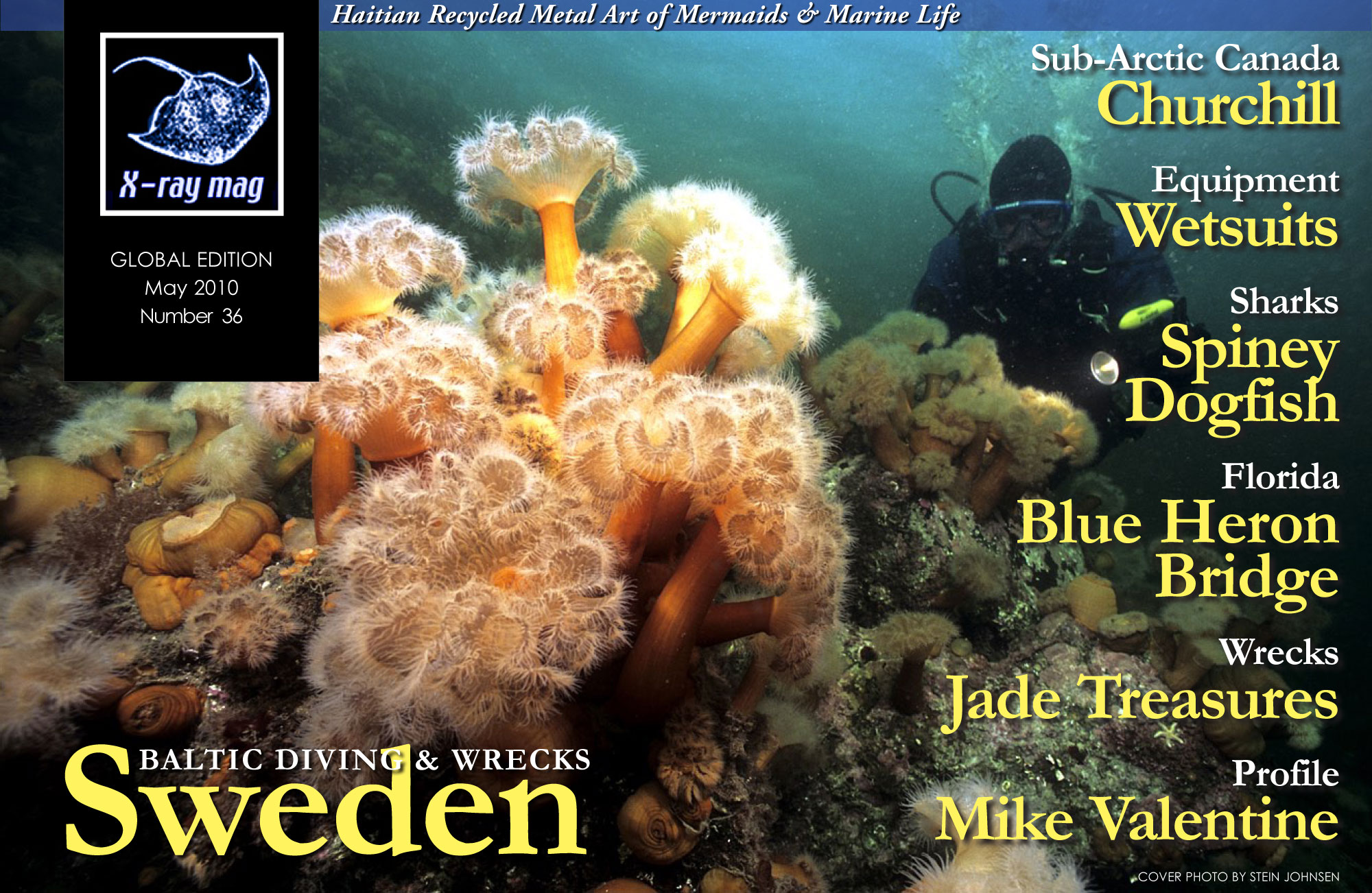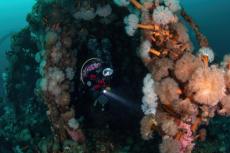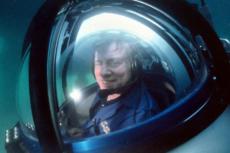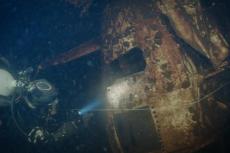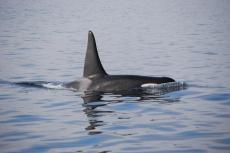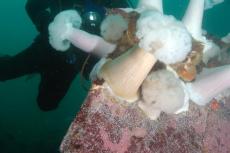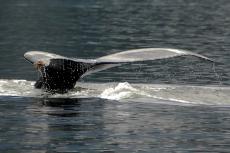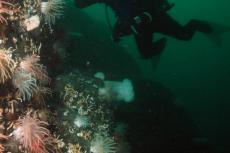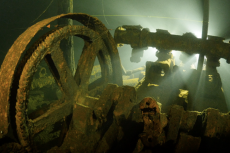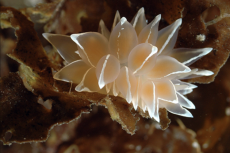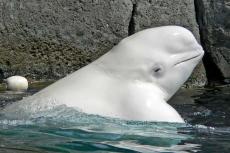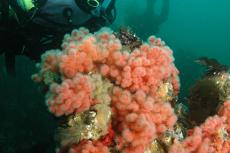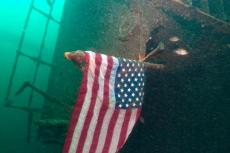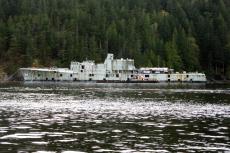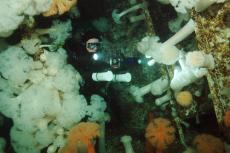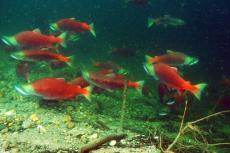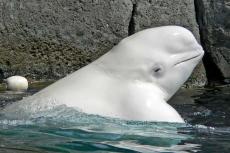Trekking Canada’s Sub-Arctic Region in Manitoba
Contributed by
Rob entered with a splash and we descended to 16 meters (55 feet) at the top of a flat pinnacle in Button Bay not far from the town of Churchill. Visibility gradually increased with depth, unlike the water temperature, which decreased to 2.7°C (37°F).
Life was indeed sparse in this harsh remote underwater wilderness, but the orange and yellow anemones, clusters of pink soft coral and several dozen decorator crabs seemed to be flourishing. Some sections were covered with dense patches of algae hiding invertebrate life, while others were bare and smooth with only a few sea stars. Hiding under a leaf of algae was a large armor-plated shrimp about the length of Rob’s hand. I later learned it was probably a ‘tank shrimp’.
As usual, I carried two cameras to document as much as possible. A high-pitched chatter of whistles and clicks seemed to tease us just out of sight. Doubting the Beluga would ever approach us underwater, I focused on obtaining macro images as quickly as possible, since my fingers were already growing numb after only 12 minutes of bottom time! Some of my photographic subjects included a small nudibranch on an orange burrowing sea cucumber, more shrimp, a few sculpins and several amphipods, with the latter found in mid-water.
Just as my face was beginning to really feel the cold, Rob appeared in front of me and motioned to turn around. Not knowing what to expect, I slowly turned to discover a massive wall of belugas! Their accumulation was so great they filled our view.
Some were vertical in the water, others watched head-on and some slowly swam by. In awe, we watched motionless as about 30 came within six meters (20 feet) of us, then parted into two sections and swam in wide circles around us with the two groups going in opposite directions. They bobbed their flexible heads—their cervical vertebrae are not fused—and swayed their 3-5 meter- (10-15 foot-) long one-ton bodies. Light vibrations seemed to emanate from them as they curiously bounced sonar echolocation waves off us for a better understanding of what we were.
“Oh shisnic!” I muttered aloud through my regulator, realizing I hadn’t fired off a single wide-angle shot. For ten minutes they swam around us, sometimes pausing just out of reach, maybe for a closer look. A baby, still gray in color, hovered close to mom and watched. I often later wondered if we might have been the objects of their study. Or…perhaps our unusual structure and sounds (tanks and bubbles) sparked an interest for them to learn more. Nonetheless, there we calmly sat, turning into scuba popsicles, experiencing one hell-of-a unique encounter, not soon to be forgotten!
Churchill
This was one of my first dives in the remote township of Churchill, Manitoba, over ten years ago. I had hooked up with Rob, an RCMP officer stationed in Churchill, through our mutual friend, Ian Hall, who operated a dive charter business in Nanaimo, British Columbia. Rob provided me with the use of tanks, weights and a means to get airfills at the local fire department.
There are mainly two ways for visitors to get to Churchill—fly or take VIA Rail, a two-day train ride from Winnipeg. Feeling adventurous I took the latter. Fortunately, I was also assigned a roomette or sleeping compartment on the train. If you are an underwater photographer, you will have an idea of how much luggage I was traveling with and how hard it is to separate a photographer from their equipment.
This tiny space was designed to accommodate only one, approximately 1.2x1.8 meters (4x6-feet) in size. Within this space was one cushioned chair next to an oversized window. A small toilet was located under the chair, and a tiny sink pulled down from the wall, complete with running water. The bed also pulled down covering the entire room. Showers and food service were in another train car. I must say though, the rhythm of the train was ever so soothing. Overall, quite the escapade!
Rob and I used a four-wheeler for the shore dives and rented a boat with a driver for deeper dives, like the one described earlier. My lodging consisted of an inexpensive local bed and breakfast lodge where I had the opportunity to meet other travelers and back-packers from around the world. For transportation, I rented an old Ford pickup.
It was July then, and colorful wildflowers covered the countryside and scented the air with the fragrance of springtime. I must have spent hours in that old truck exploring one dead-end road after another. Churchill, however, was not without its challenges, and I’m not referring to the occasional polar bears one might encounter while out for an evening stroll after a meal of caribou stew. It’s the mosquitoes.
When you have an environment such as Churchill, located on the western shore of Hudson Bay in a sub-arctic region, spring, summer and fall are limited to about ten weeks, thus creating an explosion of life! The same goes for the bugs. If I wanted to stop and photograph something—a beautiful sunset, a field of flowers or one of the 250 species of migrating birds—I had to prepare my camera while in transit. When I arrived at the preferred site, I would park the truck (still running), quickly jump out to snap off as many images as possible during an average 30-second window before being inundated by the bugs.
If more images were desired, I would simply run around the truck again for a 15-second window (bugs growing wiser to my tactics). Another sprint around the truck and I could often leap into the cab with minimal followers to later deal with.
Mosquito spray did help, but the little buggers seemed to know exactly to the second when the deterrent wore off. Even though the mosquitoes were a challenge, the journey was well worth the trip, especially to dive and see the belugas in such a natural setting.
Polar bears
Over the years, residents and business owners of Churchill have successfully survived by marketing their natural resources through ecotourism, utilizing almost every season. Visitors arriving in late October and November are able to see polar bears from the safety of customized tour buses, as the bears await the return of the pack to continue with their hunting.
Some bears tend to awake early, while others make their way back to the coast after being inland for some time. But if the bears arrive too early, they can pose a problem to unwary tourists.
I remember Rob telling me how he was part of a team who went out and rounded up bears that wandered too close to town. They would tranquilize them, put the bears into big round metal cages, and carry them off to the other side of the river away from town, or transport the bears (within the cage) by helicopter up to 20km (12.5 miles) north along the coast. He also said a few stubborn ones found their way back to town.
The bear patrol of today is still proficient in keeping the town free of roving individuals and mothers with cubs. If you happen to see a dirty-white spot out in the tundra during July or August, or along the shore near the smooth boulders, there’s a good chance it might be a polar bear—so keep in mind, they can eat you!
Arctic features
From November to March one can enjoy the brilliant colors of the Aurora Borealis dancing across the horizon. A milder version can also be seen during the summer, but not with the same grandeur. From late May ....


